All across America, thousands of unusual concrete arrows are hidden high upon hills, in deep woodlands and arid deserts. They are the last remains of a vast network that once guides planes across America in the early days of aviation. I went looking for them.In 1924, the federal government funded enormous concrete arrows to be built every 10 miles or so along established airmail routes to help the pilots trace their way across America in bad weather conditions and particularly at night, which was a more efficient time to fly.
source.image: Calum
Painted in bright yellow, they were each built alongside a 50 foot tall tower with a rotating gas-powered light and a little rest house for the folks that maintained the generators and lights. These airway beacons are said to have been visible from a distance of 10 miles high.Watch the video from Calum for more info:
In the days before high-tech navigation systems, pilots flying across the country had slightly simpler tools to point them in the right direction: a network of beacons and giant concrete arrows.Some of those arrows still exist today—huge, mysterious, brush-covered artifacts, generally in remote reaches of the country.
Advertisement
The arrows were constructed as Transcontinental Airway System between 1923 and 1934. Funded in 1923 by U.S. Congress, they connected the Atlantic and Pacific coasts in 1924, and in 1933 the system reached a total 1500 beacons, and 18,000 miles of routes.











